
Please Click On Any of the Pictures Below for a Larger Version
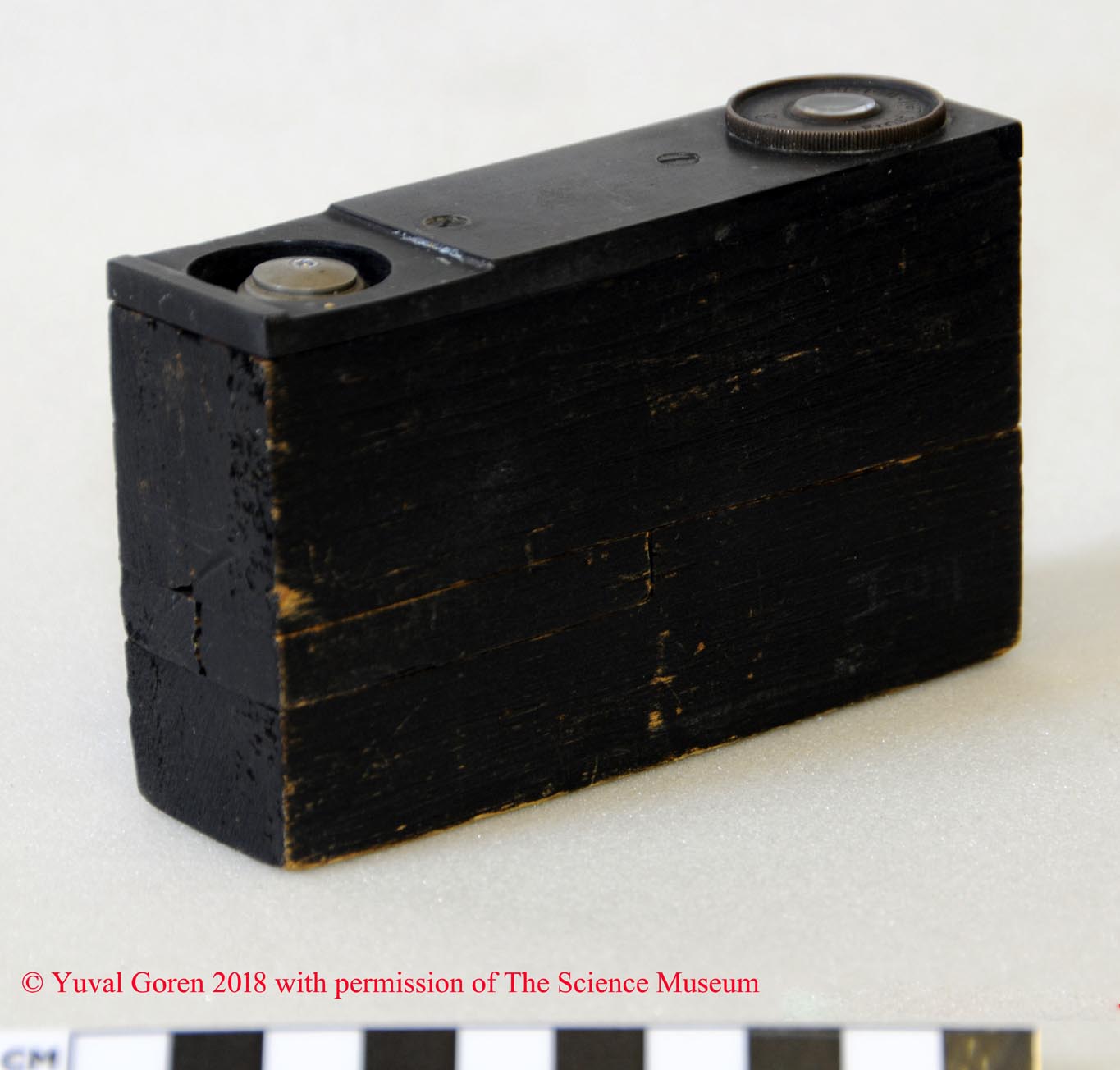
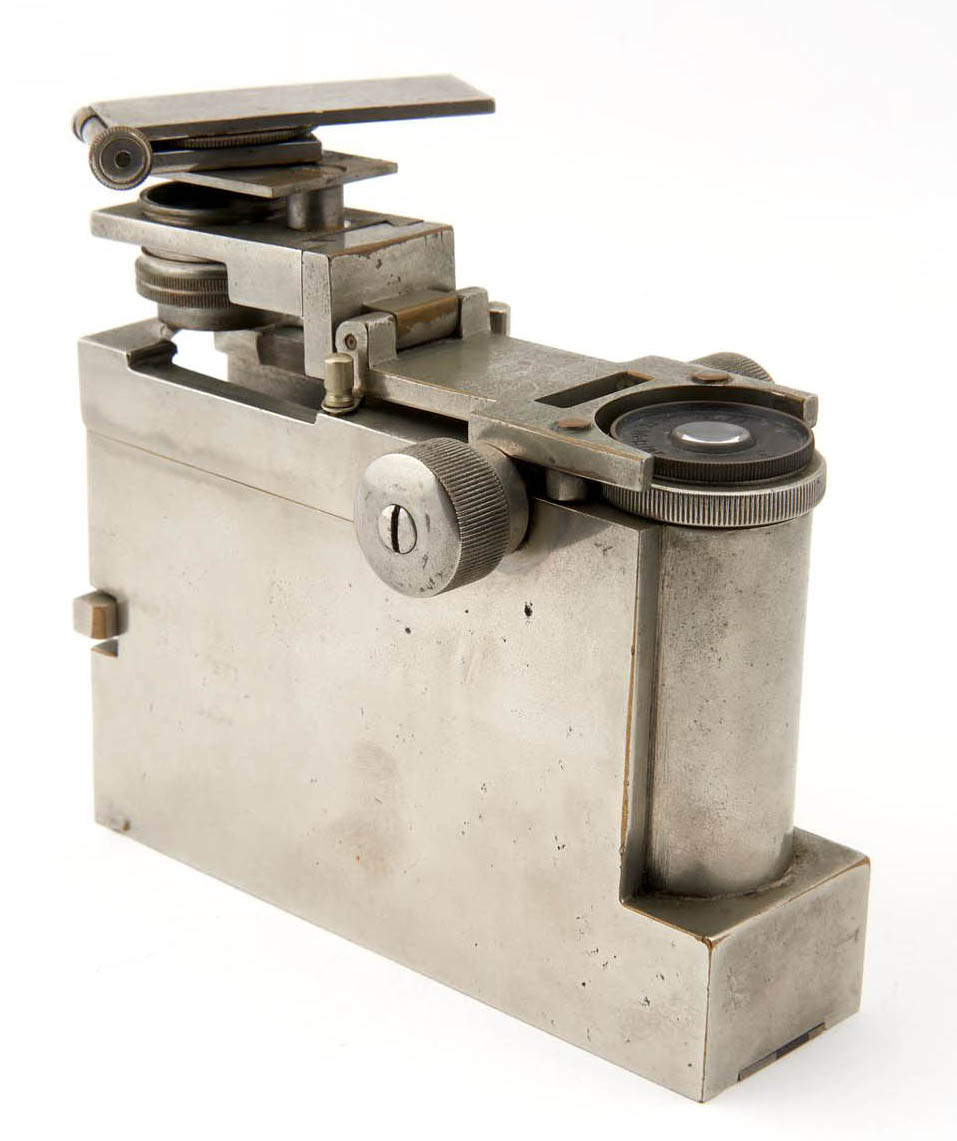 The initial prototype(left), was hand made of wood in 1930, and following that, the first metal version was made 'by McArthur' in 1932(right); this first metal instrument is part of the collection of the Royal Microscopical Society and is housed at the Museum of the History of Science at Oxford. The initial metal design, (right) as described in his 1934 article in the Journal of the Royal Microscopical Society, used full-sized objectives and used the top of the instrument as a stage. A mirror and condenser would then be on an extension of the main body of the microscope above the slide. The slide support rides on the stage forward and backward, providing a semi-mechanical movement. Since Dr McArthur was as physician, exactly how this first metal version was made is unclear, but it is likely he used a skilled machinist or company to assist him in construction. Only two of these were known to be produced and this version was apparently not sold commercially.
The initial prototype(left), was hand made of wood in 1930, and following that, the first metal version was made 'by McArthur' in 1932(right); this first metal instrument is part of the collection of the Royal Microscopical Society and is housed at the Museum of the History of Science at Oxford. The initial metal design, (right) as described in his 1934 article in the Journal of the Royal Microscopical Society, used full-sized objectives and used the top of the instrument as a stage. A mirror and condenser would then be on an extension of the main body of the microscope above the slide. The slide support rides on the stage forward and backward, providing a semi-mechanical movement. Since Dr McArthur was as physician, exactly how this first metal version was made is unclear, but it is likely he used a skilled machinist or company to assist him in construction. Only two of these were known to be produced and this version was apparently not sold commercially.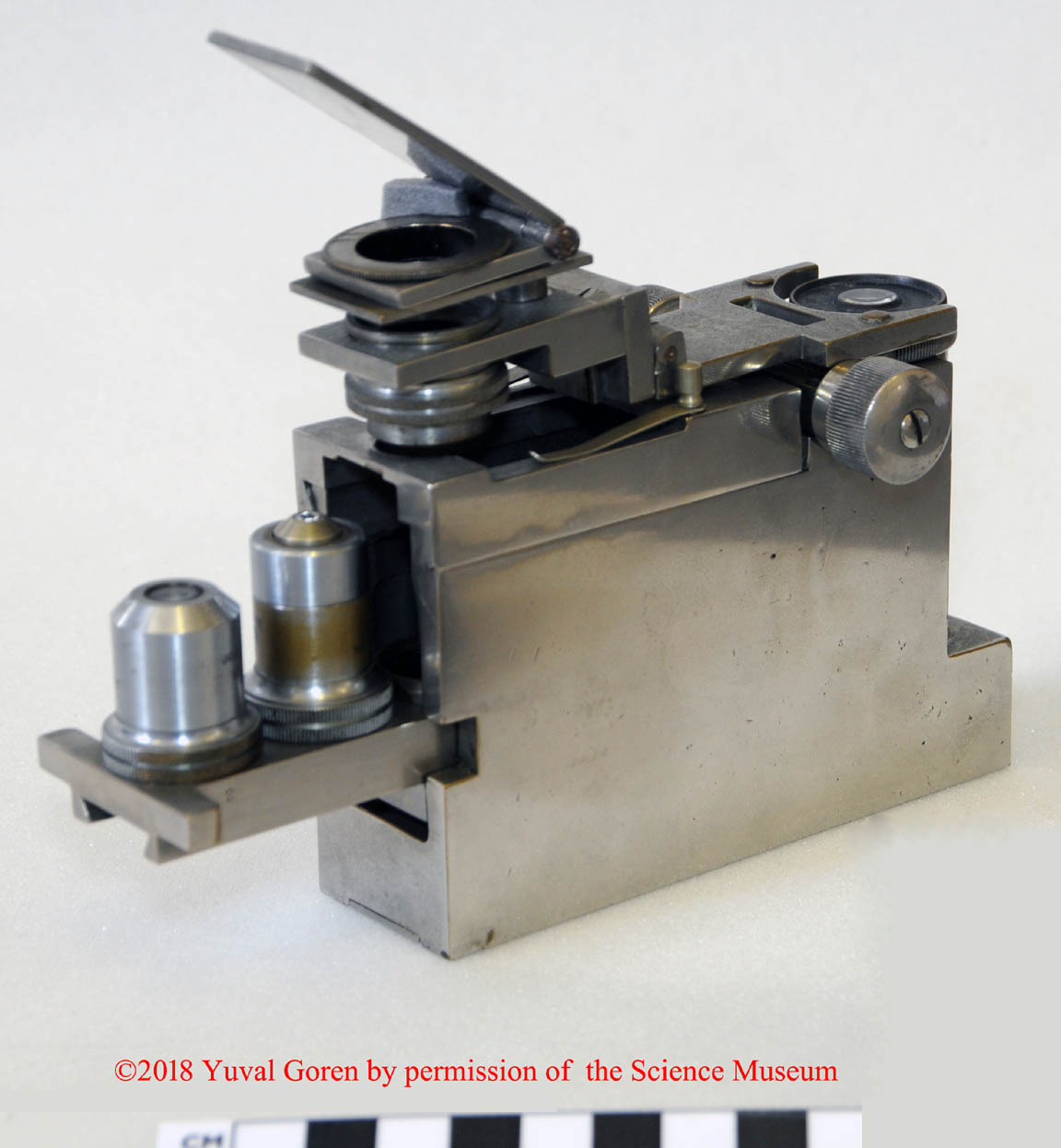 McArthur-Watson model(left), very similar to the first metal prototypes made 'by McArthur' just two or three years earlier. This form again used the less streamlined design for the bracket holding the condenser, again protruding higher above the main body of the microscope. It is unclear whether this version or the one in the next paragraph was sold first, but both were first produced about 1935. Some have argued that since this most resembles the original metal prototype, it came first. Against this is McArthur's own publications, that stated that Hearson was the first to make commercial McArthur microscopes. What is clear is that the model in the next paragraph was made at a time very close to this one.
McArthur-Watson model(left), very similar to the first metal prototypes made 'by McArthur' just two or three years earlier. This form again used the less streamlined design for the bracket holding the condenser, again protruding higher above the main body of the microscope. It is unclear whether this version or the one in the next paragraph was sold first, but both were first produced about 1935. Some have argued that since this most resembles the original metal prototype, it came first. Against this is McArthur's own publications, that stated that Hearson was the first to make commercial McArthur microscopes. What is clear is that the model in the next paragraph was made at a time very close to this one. 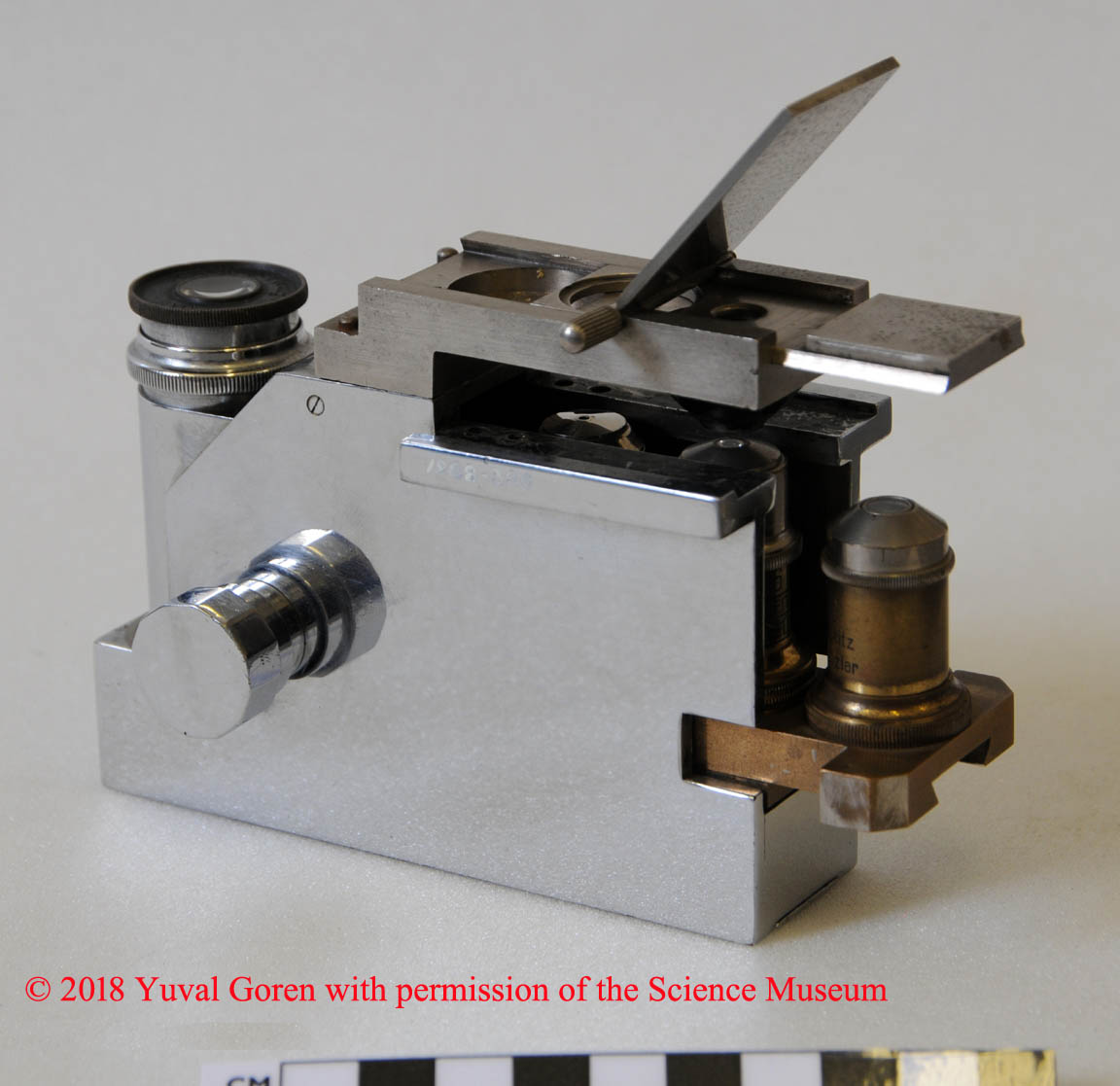 Apparently also in or about 1935, McArthur started to sell a slightly redesigned model similar to the prototype(left). This model still used full sized objectives and the stage remained at the top of the main body with the condenser and mirror assembly again protruding off the top, but this time in a more streamlined straight horizontal mounting. The semi-mechanical stage was no longer present, a fixed stage now standard. McArthur stated in his publications that Charles Hearson was the first commercial maker of his microscopes. The finish and form of this model does indeed suggest it likely was made for McArthur by Charles Hearson. It is unsigned(just like all known later Hearson Models). Like the slightly later Hearson's, the main body of the microscope has a polygonal housing for the eyepiece and a narrow shelf slants down from the top of the instrument next to the eyepiece housing.
Apparently also in or about 1935, McArthur started to sell a slightly redesigned model similar to the prototype(left). This model still used full sized objectives and the stage remained at the top of the main body with the condenser and mirror assembly again protruding off the top, but this time in a more streamlined straight horizontal mounting. The semi-mechanical stage was no longer present, a fixed stage now standard. McArthur stated in his publications that Charles Hearson was the first commercial maker of his microscopes. The finish and form of this model does indeed suggest it likely was made for McArthur by Charles Hearson. It is unsigned(just like all known later Hearson Models). Like the slightly later Hearson's, the main body of the microscope has a polygonal housing for the eyepiece and a narrow shelf slants down from the top of the instrument next to the eyepiece housing.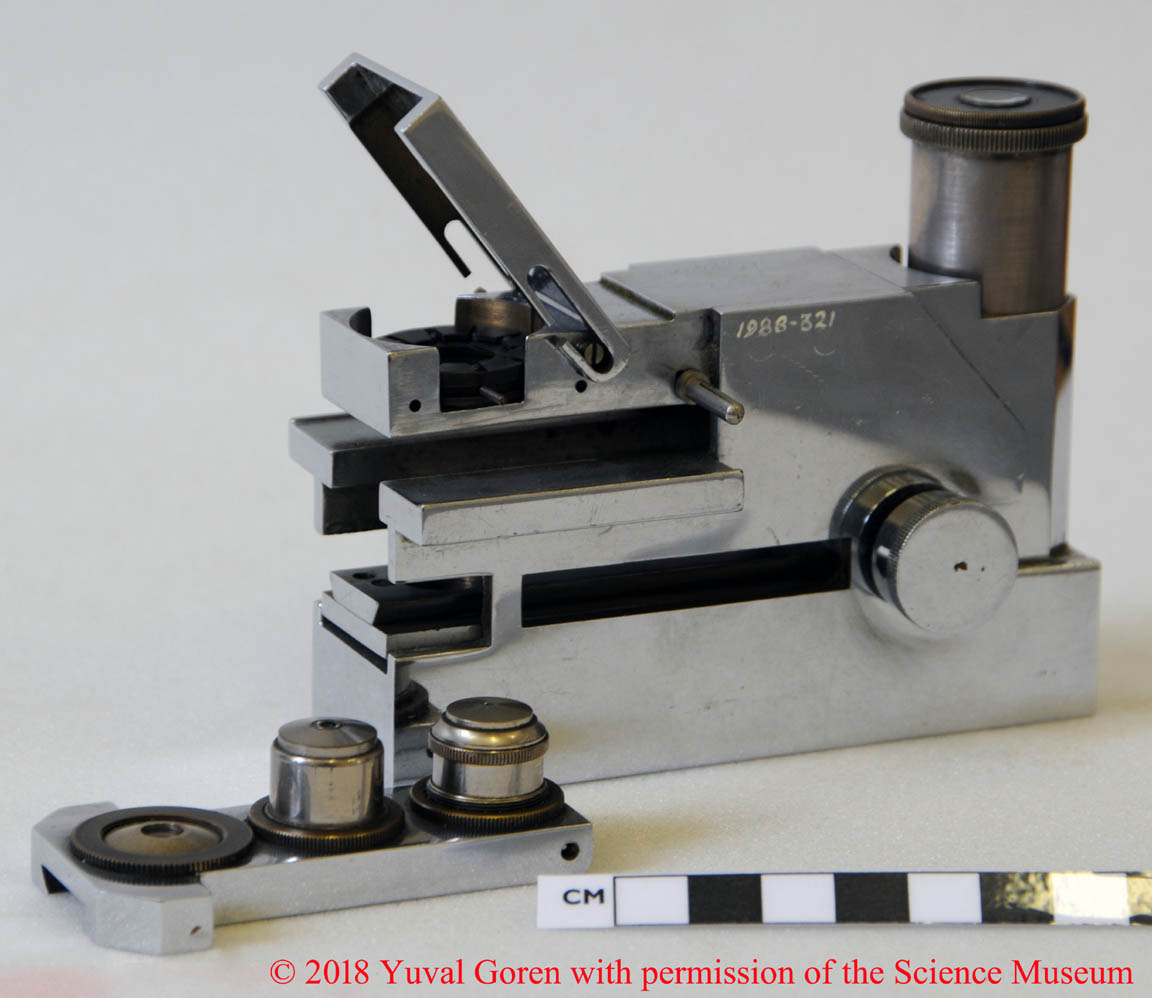
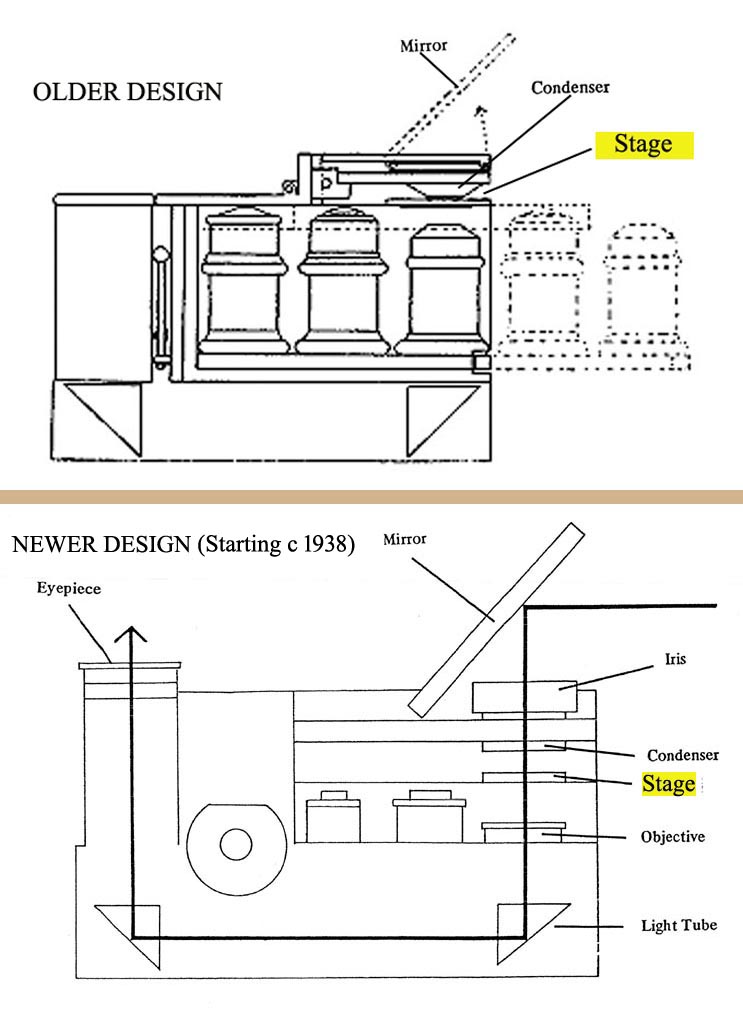 Starting about 1936, a model produced by Charles Hearson (left)incorporated special small objectives (made by Beck), and eliminated the projection off the microscope by placing the stage in the middle of the instrument. This allowed the condenser to be placed in the main body of the instrument, above the stage but not protruding unless in use. This is a much better arrangement, as it reduces the likelihood of damage or loss of parts. Compare the schematics here of the older model, and the newer version(right). According to Brian Bracegirdle, this production run was short and amounted to only about 12 microscopes, but the author is not aware of any proof of this as of May 2020. An example of this microscope with addition of a later special mechanical stage is shown on its own page.
Starting about 1936, a model produced by Charles Hearson (left)incorporated special small objectives (made by Beck), and eliminated the projection off the microscope by placing the stage in the middle of the instrument. This allowed the condenser to be placed in the main body of the instrument, above the stage but not protruding unless in use. This is a much better arrangement, as it reduces the likelihood of damage or loss of parts. Compare the schematics here of the older model, and the newer version(right). According to Brian Bracegirdle, this production run was short and amounted to only about 12 microscopes, but the author is not aware of any proof of this as of May 2020. An example of this microscope with addition of a later special mechanical stage is shown on its own page. 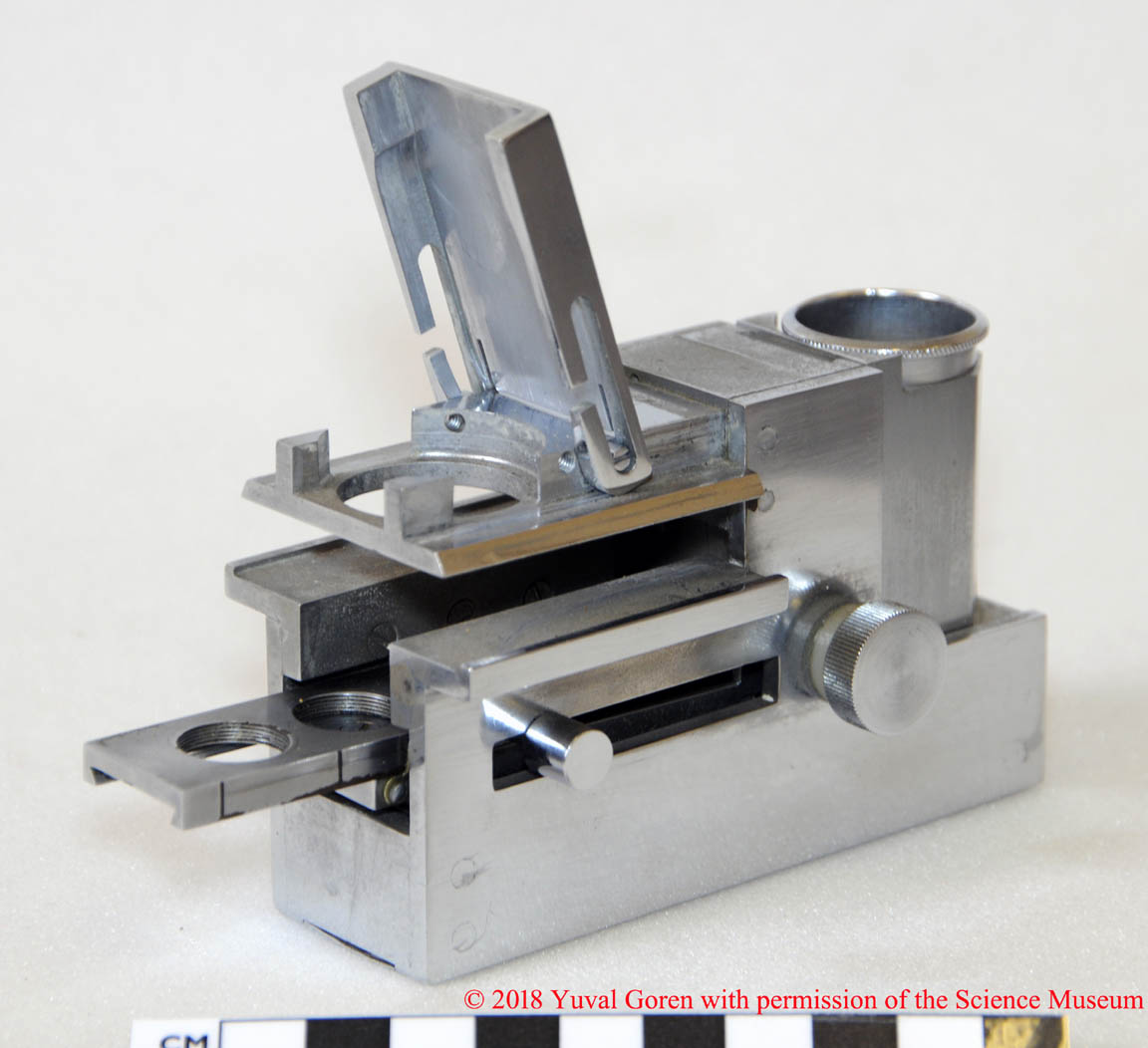 During WWII Dr McArthur was a p.o.w. During that time, he spent considerable time thinking about ways to improve his design. In 1945 he constructed, or had constructed, a model(left) which very much anticipated the final design of his microscope. It was constructed of one of the newly available lighter weight alloys. The one feature of that lighter model that did not endure was the knobs protruding from the sides to move the objective slider back and forth. This was quickly abandoned in favor of the older method of controlling the objective slider via protrusions at its front end. This latter earlier method was far less likely result in damage to the mechanism. As far as is known, this exact model was not produced for sale.
During WWII Dr McArthur was a p.o.w. During that time, he spent considerable time thinking about ways to improve his design. In 1945 he constructed, or had constructed, a model(left) which very much anticipated the final design of his microscope. It was constructed of one of the newly available lighter weight alloys. The one feature of that lighter model that did not endure was the knobs protruding from the sides to move the objective slider back and forth. This was quickly abandoned in favor of the older method of controlling the objective slider via protrusions at its front end. This latter earlier method was far less likely result in damage to the mechanism. As far as is known, this exact model was not produced for sale.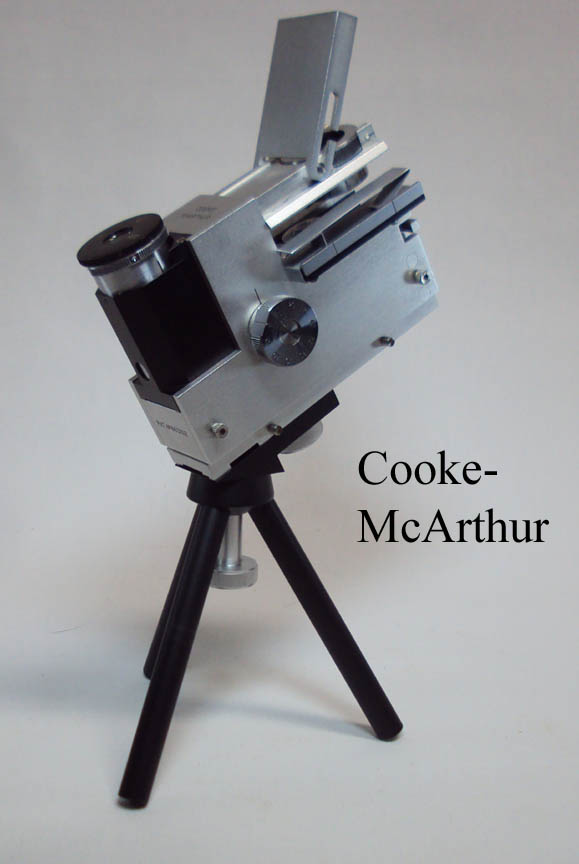 Starting in 1959, (Vickers Ltd subsidiary) Cooke, Troughton and Simms (CTS) made McArthur microscopes 'under an agreement' with Dr. McArthur, the Model known as the ‘McArthur’ when labelled with Vickers as maker and 'Cooke-McArthur' when labelled with CTS as maker. It has been reported they made them from 1959** until about at least 1969; in 1963, after acquiring C. Baker's microscope factory, Vickers instruments was formed. It is possible they continued until 1979; CTS ceased operations in 1988, but as mentioned above was a subsidiary of Vickers instruments! An image of an example of a Vickers-McArthur microscope is shown in the table below, courtesy of Dr Yuval Goren of Israel. It appears identical to the CTS model and may indeed be the same instrument. Therefore, it is likely the name of Vickers Instruments was used on the instruments starting sometime after 1962. It has been reported to me by their archivist, that Vickers/CTS made relatively small numbers of McArthur microscopes during the years.
Starting in 1959, (Vickers Ltd subsidiary) Cooke, Troughton and Simms (CTS) made McArthur microscopes 'under an agreement' with Dr. McArthur, the Model known as the ‘McArthur’ when labelled with Vickers as maker and 'Cooke-McArthur' when labelled with CTS as maker. It has been reported they made them from 1959** until about at least 1969; in 1963, after acquiring C. Baker's microscope factory, Vickers instruments was formed. It is possible they continued until 1979; CTS ceased operations in 1988, but as mentioned above was a subsidiary of Vickers instruments! An image of an example of a Vickers-McArthur microscope is shown in the table below, courtesy of Dr Yuval Goren of Israel. It appears identical to the CTS model and may indeed be the same instrument. Therefore, it is likely the name of Vickers Instruments was used on the instruments starting sometime after 1962. It has been reported to me by their archivist, that Vickers/CTS made relatively small numbers of McArthur microscopes during the years. 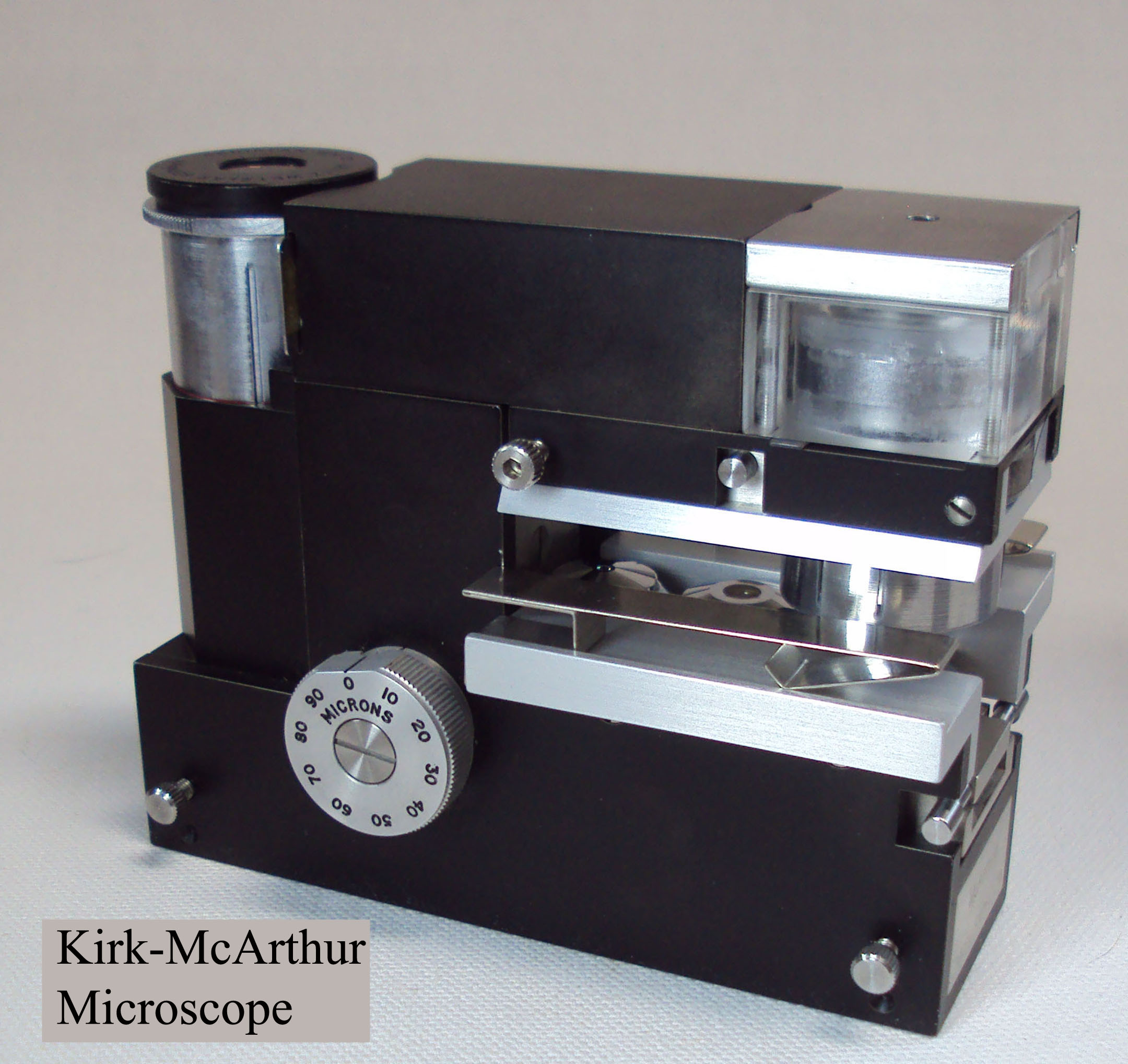 The McArthur model made circa 1988 until about 1993, under license from McArthur Microscopes Ltd, was the Kirk-McArthur, made by K.W. Kirk and sons. The Kirk models from this era had serial numbers 86/1 through 86/19, and then were numbered from 2001 through 2890. Number 2220 was from 1989. The Kirk-McArthur came in standard biological, phase contrast, surface inspection, and metallurgical models and could even be equipped as an interferometer for inspecting optical fiber cleavage. The surface inspection model and the metallurgical model could be acquired together as a kit combining the common elements of both with the two different optical tube assemblies added; this kit was known as the 'Engineering Model.' The example of the Engineering model that I have came in a purpose-made blue plastic case with a foam lining, with cutouts for the microscope and accessories. I am aware that early McArthur scopes had a leather case, and the Cooke-McArthur had a clear plastic case.
The McArthur model made circa 1988 until about 1993, under license from McArthur Microscopes Ltd, was the Kirk-McArthur, made by K.W. Kirk and sons. The Kirk models from this era had serial numbers 86/1 through 86/19, and then were numbered from 2001 through 2890. Number 2220 was from 1989. The Kirk-McArthur came in standard biological, phase contrast, surface inspection, and metallurgical models and could even be equipped as an interferometer for inspecting optical fiber cleavage. The surface inspection model and the metallurgical model could be acquired together as a kit combining the common elements of both with the two different optical tube assemblies added; this kit was known as the 'Engineering Model.' The example of the Engineering model that I have came in a purpose-made blue plastic case with a foam lining, with cutouts for the microscope and accessories. I am aware that early McArthur scopes had a leather case, and the Cooke-McArthur had a clear plastic case.
Loupe Microscopemade by the Cogit optical company in France. It has a 'U-shaped' optical path utilizing four prisms. It is a most compact but fixed lens microscope of relatively low power. Very little is known about its history at this time and I would be grateful for information about it. I would like to thank Martin Mach for allowing me to link to the image on his website.